Schneider Shorts of 5 November 2021 – retractions, partial retractions and corrections, good Russian vaccines and bad western ones, Ayurveda in Germany, why alcoholism saves lives, old age smart-bombed, Daszak supervising himself, an old diva being nasty again, and a very special family business.
Table of Discontent
Science Elites
- Aguzzi being himself – EMBO celebrates someone they really shouldn’t
- Family Business – research integrity with Ilana and Dror Kolodkin-Gal
- Some conclusions unaffected – Titia De Lange wants you to trust the rest
- Partial Fraud – Also Hetz declares conclusions unaffected
- Paper put out of its misery – After Stebbing’s fall, his fake paper falls also
- The innocence of Nitsch – a German professor earns another retraction
COVID-19
- Pfizer vaccine scandal! – The BMJ scoop can misfire badly
- Sputnik III – No need for WHO or EMA approval if you get third Lancet paper!
- Curcumin AND Licorice! – Professor Krawczyk deploys another spice
- English Business – false negative COVID-19 PCR, but who cares…
- Lab Leak Theory – NIH let Daszak supervise himself
Science Breakthroughs
- Cure for Diabetes – Israeli Scientists found one
- More Senolytics! – Smart-bombing old age
- Alcohol saves! – Drink booze or you will die
News in Tweets
Science Elites
Aguzzi being himself
The European Molecular Biology Organization (EMBO) brought a podcast, an interview with the Adriano Aguzzi, University of Zürich professor with an imaginary PhD degree but with a very real and serious PubPeer record.
“EMBO Member Adriano Aguzzi is the Director of the Institute of Neuropathology at the University of Zurich. The Aguzzi lab investigates the molecular basis of prion diseases and other neurodegenerative illnesses. We spoke with Adriano Aguzzi and Review Commons project leader Thomas Lemberger about preprints, peer review, paying for innovation in publishing, and an unexpected positive control.”
Aguzzi is also a diva with bullying tendencies who likes to call his critics “lowlifes” and eagerly slanders them with accusations of crime or fraud.
Like here, our diva lashing out against a postdoc who dared to inform EMBO about the manipulated data in Aguzzi’s papers:
“for being a young postdoc, it seems that you have a pretty impressive pubpeer record yourself“

Aguzzi’s charges of research misconduct against Devang Mehta (who incidentally did PhD in Zürich) were not just false, they were, what irony, apparently digitally manipulated:
I wrote to EMBO, but nobody replied. Also the University of Zürich ceased all communication with me, guess the earlier announcements of an investigation by the Vice-Rector for Research were a private joke (btw, Christian Schwarzenegger happens to be a nephew of the famous US film actor and politician). Elisabeth Bik then went to PubPeer to ask Aguzzi if he ever plans to correct his papers as he promised. Silence there also. So Elisabeth found another rotten paper:
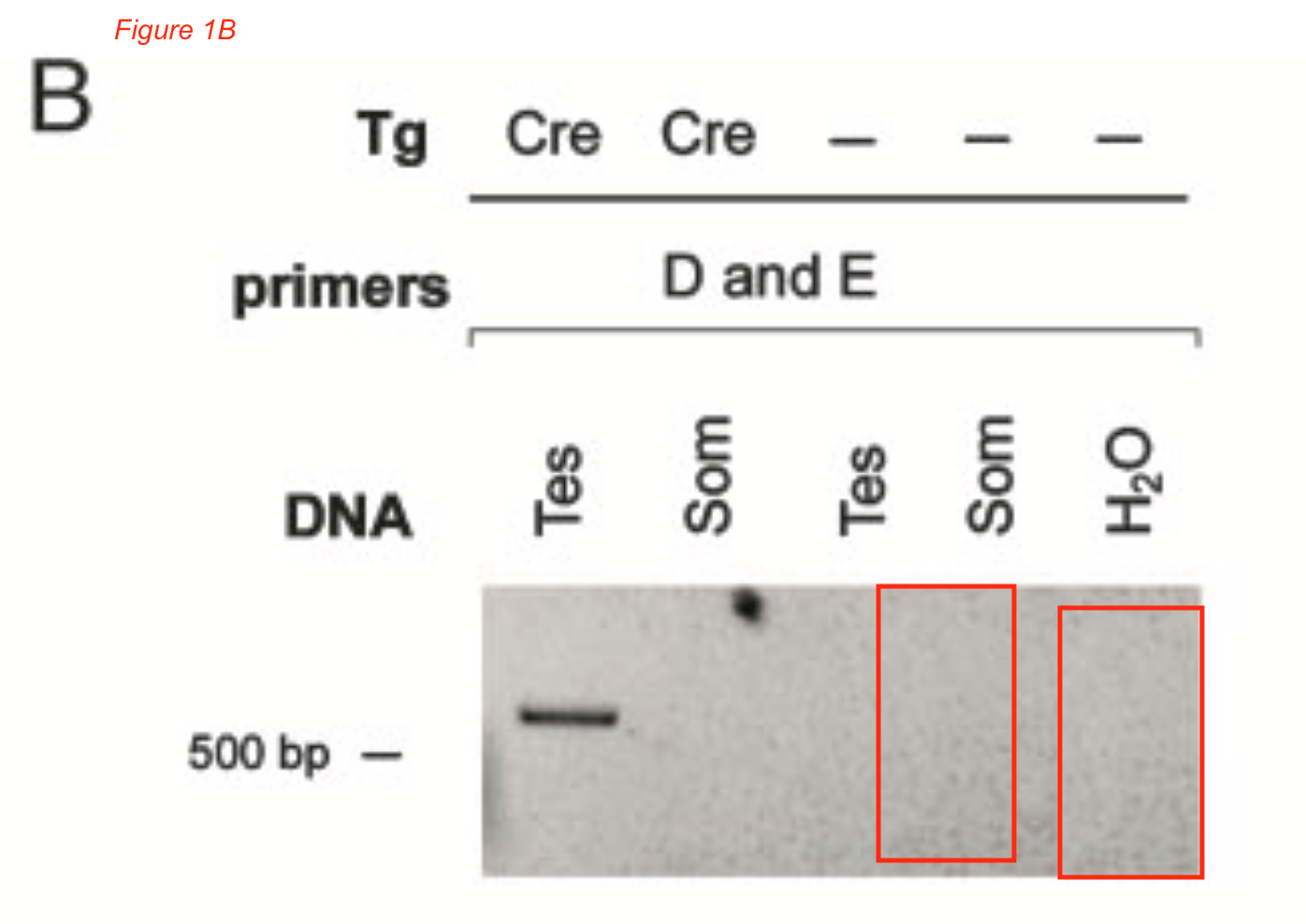
Nicolas Genoud , Axel Behrens , Gino Miele , Dimitri Robay , Frank L Heppner , Stefan Freigang , Adriano Aguzzi Disruption of Doppel prevents neurodegeneration in mice with extensive Prnp deletions Proceedings of the National Academy of Sciences (2004) doi: 10.1073/pnas.0400131101
Family business
It’s not just Aguzzi who is taking charge of research integrity, like a goat self-appointing as gardener. Faced with the problem that there are real sleuths at work who can’t be bribed or threatened, science elites scramble to control the debate and the market.
Dror Kolodkin-Gal, the husband of the Weizmann Institute researcher Ilana Kolodkin-Gal (who earned a retraction and an expression of concern for data manipulation in Photoshop, and has more on PubPeer) founded a successful company named Proofig which offers…
“Automated Image Proofing for Scientific Integrity“
The customers are scientific journals, and the Kolodkin-Gal family business flourishes. Scholalry publishers are not interested in banishing fraudsters, they merely don’t want to be caught with their fraud.
This is how the company advertises, with a quote of its owner:
Dr Dror Kolodkin-Gal: “As a senior researcher in life sciences, I became all too familiar with the damaging problem of inadvertent image duplication in scientific publications. My awareness of the massive prices paid by my colleagues and the esteemed journals in which their studies are published, which damages the integrity of the scientific process itself, is precisely what motivated me to found Proofig.”
Does Dror train his software on Ilana’s papers?
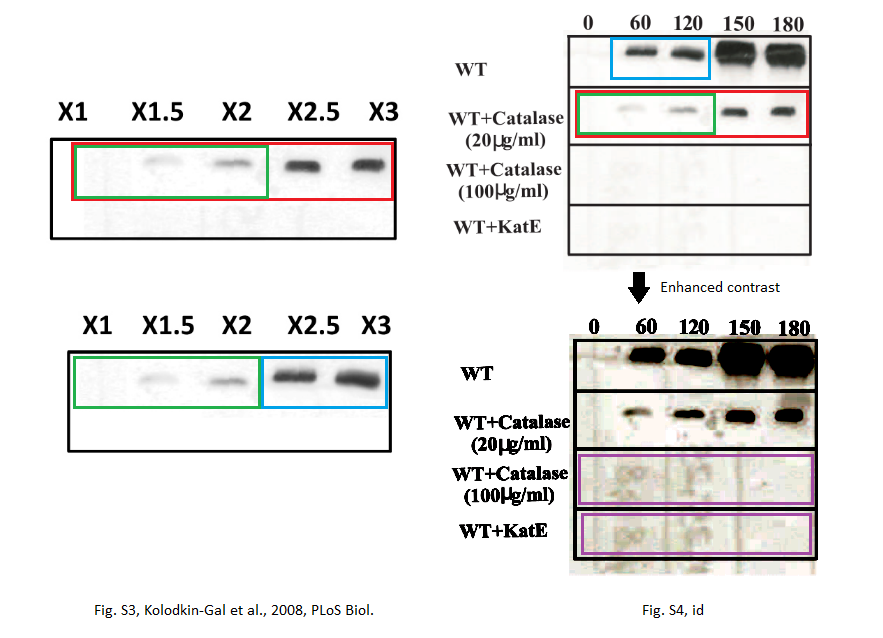
This all is beyond satire.
Some conclusions unaffected
The Rockefeller University professor Titia De Lange is a bigwig of telomere research, and now she issued a very embarrassing correction. For which De Lange can thank her former postdoc Eros Lazzerini Denchi, now principal investigator at NIH’s National Cancer Institute (NCI).
E. Lazzerini Denchi , G. Celli, T. De Lange Hepatocytes with extensive telomere deprotection and fusion remain viable and regenerate liver mass through endoreduplication Genes & Development (2006) doi: 10.1101/gad.1453606
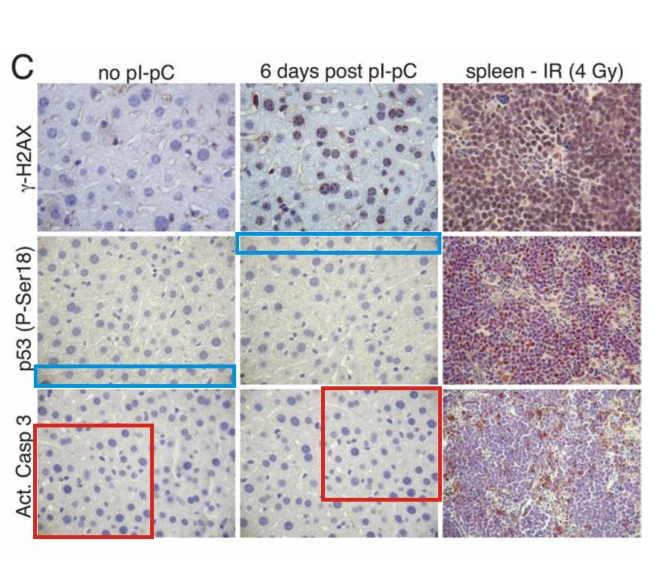
The lengthy correction notice mentions:
“In the original version of the above-mentioned article, the authors mistakenly used incorrectly labeled images for the immunohistochemistry panels in Figure 2C that were used to detect p53 and Caspase-3 in liver sections of Mx-Cre TRF2F/− mice either untreated or 6 d following pI-pC administration. […] We were able to recover data from an earlier p53 (P-Ser18) staining experiment and these images were used to correct Figure 2C below. Please note that, unfortunately, our 2004/2005 electronic records of liver IHC for activated Caspase 3, while containing many negative images, were not appropriately labeled. Therefore, the Caspase-3 data have not been replaced, as we cannot assign images as control and experimental representatives unequivocally. References to Caspase-3 activation in the text in the following places should be omitted:…”
All references to apoptosis in the paper had to be removed. But sure, trust the rest:
“The authors apologize for this regrettable error. This error does not alter the results or conclusions drawn from the experiments presented in the article.”
Lazzerini Denchi has more on PubPeer, much worse stuff, back from IFOM in Milan, Italy, with his PhD mentor Kristian Helin.
Partial fraud
The neuroscientist Claudio Hetz somehow managed to escape research misconduct charges by his University of Chile. And his paper in EMBO Journal escaped a retraction!
Karen Castillo, Diego Rojas-Rivera, Fernanda Lisbona, Benjamín Caballero, Melissa Nassif, Felipe A Court, Sebastian Schuck, Consuelo Ibar, Peter Walter, Jimena Sierralta, Alvaro Glavic, Claudio Hetz BAX inhibitor-1 regulates autophagy by controlling the IRE1α branch of the unfolded protein response The EMBO Journal (2011) doi: 10.1038/emboj.2011.318
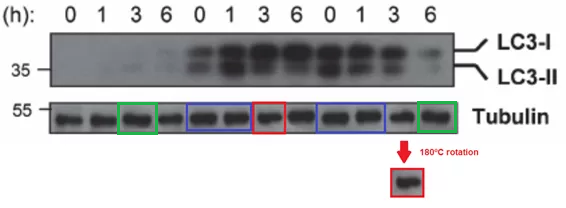
Just one figure was retracted, it was too fraudulent, as the notice goes:
“Journal statement:
The journal was informed of potential image aberrations in Fig 6B (duplicated bands within tubulin control blot). The journal was unable to obtain source data and concluded there is a high probability of duplications within Fig 6B. The journal is herewith retracting Fig 6B.
Author statement:
We regret to be unable to locate the original tubulin blot from the study, although we recovered original films for the LC3 experiments. We would like to state that the overall conclusions of the study are not affected by the retraction of Fig 6B….”
Paper put out of its misery
Now that the reputation of the Imperial College London professor and quack oncologist Justin Stebbing is finally entirely in the toilet what with the recent ruling by the medical tribunal (read here, here and here), the journal Nucleic Acids Research saw it as safe to finally retract Stebbing’s hilariously fraudulent paper with his mentee Georgios Giamas (now professor at University of Sussex). I wrote about that case already 4 years ago.
Here it was, that zombie paper:
Georgios Giamas, Leandro Castellano, Qin Feng, Uwe Knippschild, Jimmy Jacob, Ross S. Thomas, R. Charles Coombes, Carolyn L. Smith, Long R. Jiao, Justin Stebbing CK1delta modulates the transcriptional activity of ERalpha via AIB1 in an estrogen-dependent manner and regulates ERalpha-AIB1 interactions Nucleic Acids Research (2009) doi: 10.1093/nar/gkp136
The October 2021 retraction notice goes:
“Following initial allegations of image manipulation in 2017 in the above article (1) the journal investigated the matter and did not find conclusive evidence to support the allegations. When further allegations were raised in 2021, the journal referred the matter to the authors’ institutions and an Expression of Concern was published in NAR (2). The Editors of the journal are now retracting the article for the following reasons:
The authors have been unable to produce the original raw image files for either the journal or the institutions.
The authors’ institutions conducted a formal investigation, and the official report dated 26-Aug-2021 concludes: ‘although the results themselves are not in question (having been verified by the subsequent repeat experiments carried out by the authors), the paper should still be retracted on the basis that the original data is no longer available, and was not available in 2017 when these concerns were first raised.”
There has been no new evidence between 2017 and 2021. The only thing which changed was Stebbing’s utter disgrace and public shaming, which didn’t come as surpise either and dragged on for years.
The innocence of Nitsch
Out of the blue, another retraction for Robert Nitsch, a controversial German neuroscientist who nevertheless remains a bigwig and a Leopoldina academy member. Nitsch used to be professor at the Charité Berlin, which he left in 2009 to become professor at the University of Mainz quite far away. In 2017, he moved again, to become CEO and medical director of the University Clinic Münster. In between, Nitsch had to retract a paper (Meier et al FASEB J 2003) in 2011, strangely after he already negotiated a correction with the editor. That was because Charite charged the last author Nicolai Savaskan with research misconduct, other authors were absolved. Savaskan left academia in 2009, and in 2020 he became public health office director of a Berlin district, handling COVID-19.
While in Mainz, Nitsch was subjected to allegations of research misconduct by a whistleblower. As Retraction Watch reported in 2012, the university investigated, and found “no evidence for any involvement of Professor Nitsch in any kind of scientific misconduct“, which in Germany often means that there very well may have been lots of misconduct in those papers, but the respondent is deemed innocent of it, which closes the case. The University of Mainz also lashed out at the whistleblower whom it accused of all possible things.
In 2013, armed with the Mainz findings, Nitsch and Savaskan sued Charite and won, all misconduct charges were dropped, the court decreed that the university had no right to meddle into a scientific dispute about figures in a paper. The German media celebrated the genius scientists being vindicated while taunting the Charite (I want to hug and kiss these Zeit journalists).
Now another retraction for Nitsch, in same journal:
F Gregory Wulczyn 1, Lena Smirnova, Agnieszka Rybak, Christine Brandt, Erik Kwidzinski, Olaf Ninnemann, Michael Strehle, Andrea Seiler, Stefan Schumacher, Robert Nitsch Post-transcriptional regulation of the let-7 microRNA during neural cell specification FASEB J (2007) doi: 10.1096/fj.06-6130com.
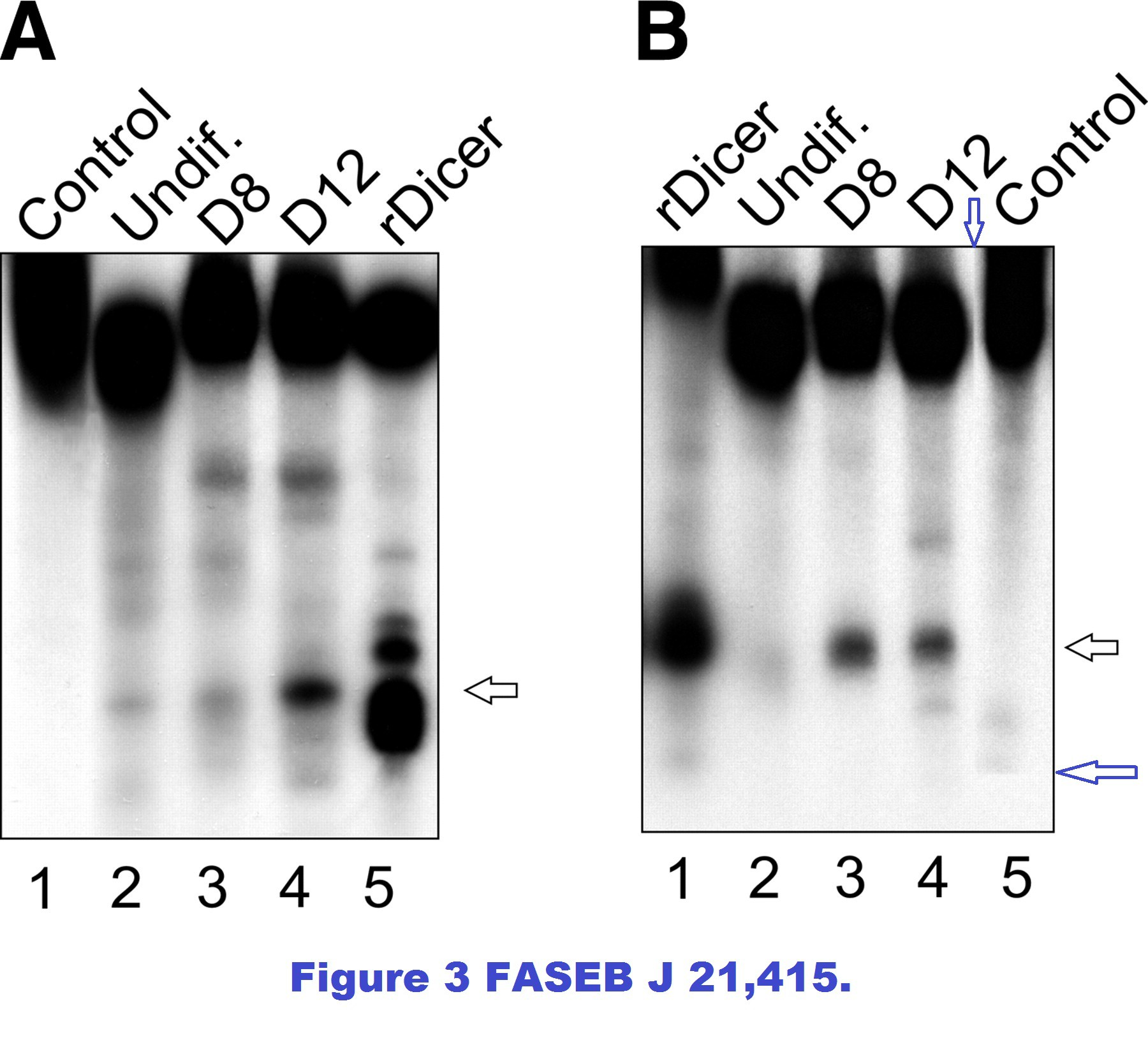
The retraction notice from 29 October 2021 went:
“The retraction has been agreed following an institutional investigation conducted by the Research Integrity Office at Charité – Universitätsmedizin Berlin which found evidence of image manipulation, in particular related to Supplemental Figure 1C. Dr Wulczyn takes full and sole responsibility for any improper manipulation of the primary data in the generation of the figures which occurred without knowledge or consent of the other authors.”
Obviously Nitsch, who after 2 years stopped being Münster University Clinic CEO to focus on his lab at the University of Münster, has nothing to do with that, or else. The official culprit Gregory Wulczyn is currently acting as deputy head of the Institute of Cell Biology and Neurobiology at Charite, which was previously led by Nitsch. Now Cheshire found this:
Elisa Cuevas , Agnieszka Rybak-Wolf , Anna M. Rohde , Duong T. T. Nguyen , F. Gregory Wulczyn Lin41/Trim71 is essential for mouse development and specifically expressed in postnatal ependymal cells of the brain Frontiers in Cell and Developmental Biology (2015) doi: 10.3389/fcell.2015.00020
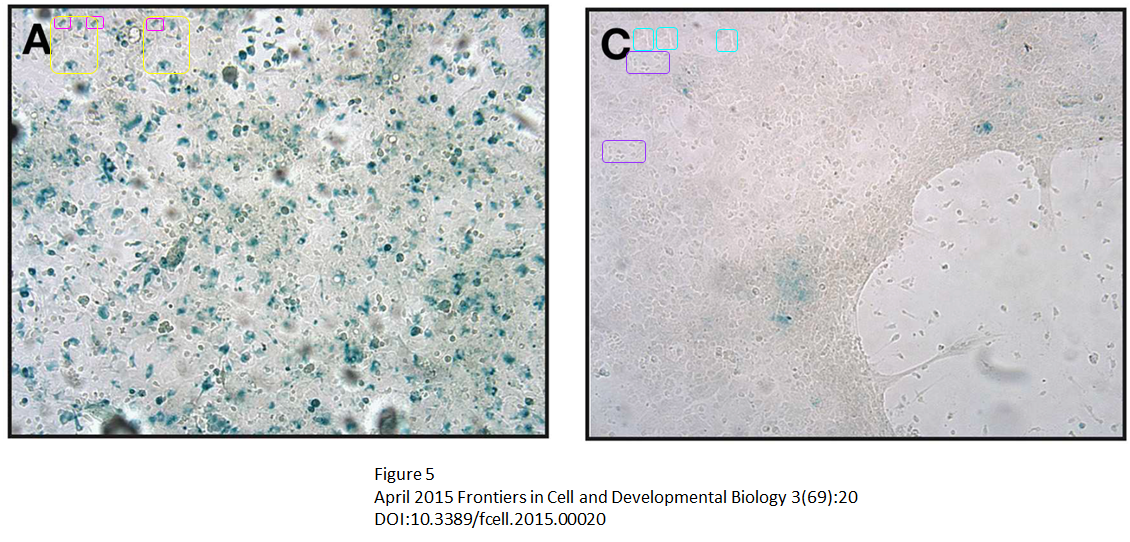
Maybe another Berlin public health office needs a new director?
COVID-19
Pfizer vaccine scandal!
The BMJ brings a huge scoop by the journalist Paul Thacker:
“Covid-19: Researcher blows the whistle on data integrity issues in Pfizer’s vaccine trial“
We all were told that the Pfizer/Biontech COVID-19 vaccine was safe and that it worked but:
“But, for researchers who were testing Pfizer’s vaccine at several sites in Texas during that autumn, speed may have come at the cost of data integrity and patient safety. A regional director who was employed at the research organisation Ventavia Research Group has told The BMJ that the company falsified data, unblinded patients, employed inadequately trained vaccinators, and was slow to follow up on adverse events reported in Pfizer’s pivotal phase III trial. Staff who conducted quality control checks were overwhelmed by the volume of problems they were finding. After repeatedly notifying Ventavia of these problems, the regional director, Brook Jackson, emailed a complaint to the US Food and Drug Administration (FDA). Ventavia fired her later the same day. Jackson has provided The BMJ with dozens of internal company documents, photos, audio recordings, and emails.”
Maybe the scandal is actually much smaller than the opening suggests. Ventavia seems to be indeed a mess, where fraud, incompetence and negligence are commonplace, and yes, FDA utterly failed in its supervisory duties. Those are serious issues, but it doesn’t mean the vaccine is not to be trusted anymore. Ventavia only dealt with 1000 participants (or less) out of 44 thousands Pfizer’s phase 3 trial had. It is not clear if Pfizer knew of the shenanigans at that contractor at that time, but it is known that several hundred trial participants were removed for protocol violations, those may or may not be associated with Ventavia. The BMJ article ends with:
“A second employee also described an environment at Ventavia unlike any she had experienced in her 20 years doing research. She told The BMJ that, shortly after Ventavia fired Jackson, Pfizer was notified of problems at Ventavia with the vaccine trial and that an audit took place.
Since Jackson reported problems with Ventavia to the FDA in September 2020, Pfizer has hired Ventavia as a research subcontractor on four other vaccine clinical trials (covid-19 vaccine in children and young adults, pregnant women, and a booster dose, as well an RSV vaccine trial; NCT04816643, NCT04754594, NCT04955626, NCT05035212). The advisory committee for the Centers for Disease Control and Prevention is set to discuss the covid-19 paediatric vaccine trial on 2 November.”
The Russian state-controlled media is having a field day warning the world how fraudulent Pfizer vaccine allegedly is. What can you expect, Kremlin chose a very unusual path to dealing with the pandemic: the zero-sum game approach it applies to everything else. Unable or rather unwilling to protect its own people, Putin’s regime decided to make the situation worse in the “West” which it perceives as its enemy. So the strategy is to sow antivax sentiments through every channel possible: official and social media and cash support for far-right covidiot protesters abroad. Good thing some dissident Russian media fights against this current disinformation campaign and explains what the BMJ story really means (e.g., The Insider).
Sputnik III
The COVID-19 vaccine Sputnik V was supposed to be a propaganda success where the world would thank Russia on its knees and reward it with all of Ukraine and maybe even the Baltic states. Problem was, Sputnik’s clinical trial data and the conditions in which it’s manufactured seem to be such a fraudulent mess that Putin’s regime is not prepared to disclose those to anyone, making an approval by WHO or EMA unlikely. Even perfectly reasonable arguments by Russia like warmongering in Ukraine, cancellation of gas supplies to EU and threats of World War III against NATO didn’t help. But Kremlin has always been the master of playing the West on its weaknesses.
So here is the THIRD paper on Sputnik V which Russia placed in The Lancet, because that journal and its mothership Elsevier care only about money and nothing else, research fraud and ethics breaches being key part of the business model.
Amir I. Tukhvatulin, Inna V. Dolzhikova, Dmitry V. Shcheblyakov, Olga V. Zubkova, Alina S. Dzharullaeva, Anna V. Kovyrshina, Nadezhda L. Lubenets, Daria M. Grousova, Alina S. Erokhova, Andrei G. Botikov, Fatima M. Izhaeva, Olga Popova, Tatiana A. Ozharovskaia Ilias B. Esmagambetov Irina A. Favorskaya Denis I. Zrelkin Daria V. Voronina Dmitry N. Shcherbinin Alexander S. Semikhin Yana V. Simakova Elizaveta A. Tokarskaya Maksim M. Shmarov Natalia A. Nikitenko Vladimir A. Gushchin Elena A. Smolyarchuk Tatiana G. Zubkova Konstantin A. Zakharov Vasiliy B. Vasilyuk Sergei V. Borisevich Boris S. Naroditsky Denis Y. Logunov Alexander L. Gintsburg An open, non-randomised, phase 1/2 trial on the safety, tolerability, and immunogenicity of single-dose vaccine “Sputnik Light” for prevention of coronavirus infection in healthy adults The Lancet (2021) doi: 10.1016/j.lanepe.2021.100241
The paper opens with:
“While the world is experiencing another wave of COVID-19 pandemic, global vaccination program is hampered by an evident shortage in the supply of licensed vaccines. In an effort to satisfy vaccine demands we developed a new single-dose vaccine based on recombinant adenovirus type 26 (rAd26) vector carrying the gene for severe acute respiratory syndrome coronavirus 2 (SARS-CoV-2) spike (S) glycoprotein – “Sputnik Light”.”
As it is custom with Sputnik V, the safety profile and the efficacy are no less than 100% (“No serious adverse events” and “100% seroconversion rate“). Thanks to a crooked Editor-in-Chief and some secret reviewers who can be anyone or no-one, this is the third Sputnik paper to be published in The Lancet, impact factor 59. Which is enough as an argument to get certain Putin-friendly governments approve this new “Light” vaccine and overrule its own regulatory authorities as it happened before with Sputnik V.
Curcumin AND Licorice!
The quacks of Indian Ayurveda and Traditional Chinese and Persian Medicines have been teaching this since the begin of pandemic: curcumin, the active ingredient in the spice turmeric made from curcuma root, is the cure for all diseases and in particular for COVID-19. A PubMed search for “curcumin and COVID-19” provides over 120 results.
Now German scientists prove them right:
Maren Bormann , Mira Alt , Leonie Schipper , Lukas Van De Sand , Vu Thuy Khanh Le-Trilling , Lydia Rink , Natalie Heinen , Rabea Julia Madel , Mona Otte , Korbinian Wuensch , Christiane Silke Heilingloh , Thorsten Mueller , Ulf Dittmer , Carina Elsner , Stephanie Pfaender , Mirko Trilling , Oliver Witzke , Adalbert Krawczyk Turmeric Root and Its Bioactive Ingredient Curcumin Effectively Neutralize SARS-CoV-2 In Vitro Viruses (2021) doi: 10.3390/v13101914
The authors mention curcumin works against SARS-CoV2 even better than chloroquine! News Medical explains:
“Significantly, this study demonstrated for the first time a potent antiviral activity of turmeric root and its bioactive ingredient curcumin against SARS-CoV-2 on Vero-E6 and Calu-3 cells.
Further, the researchers performed a dose-dependent activity of curcumin on the SARS-CoV-2 RNA genome copy numbers and found an EC50 of about 14 µg/mL (about 38 µM). The results correlated well with the above-mentioned observations of neutralization efficacy.”
It is difficult to reach this concentration of curcumin orally, what with the safety profile the authors themselves declare: “European Food Safety Authority (EFSA) panel concluded that evidence supports an acceptable daily intake (ADI) of 3 mg/kg bodyweight per day for curcumin“. But curcumin can be injected into bloodstream, and it sure will prevent COVID-19 with 100% efficiency, by killing you.
You may have noticed, the game-changing results appeared in MDPI, which is a message in itself. As it happens, the team is led by the same Adalbert Krawczyk, virology researcher at the University Clinic Essen who told us that licorice was the cure for COVID-19! The groundbreaking discovery was first issued as preprint, the celebrated by the University of Duisburg-Essen and German media, and later passed peer review in the same MDPI journal where the curcumin masterpiece appeared.
Lukas Van De Sand , Maren Bormann , Mira Alt , Leonie Schipper , Christiane Silke Heilingloh , Eike Steinmann , Daniel Todt , Ulf Dittmer , Carina Elsner , Oliver Witzke , Adalbert Krawczyk Glycyrrhizin Effectively Inhibits SARS-CoV-2 Replication by Inhibiting the Viral Main Protease Viruses (2021) doi: 10.3390/v13040609
What food ingredient next to check as COVID-19 medicine for world’s greatest and award-winning genius Professor Krawczyk?
English Business
A company in UK has been issuing negative PCR tests to people who actually were infected with the coronavirus. Good Law Project now threatens a lawsuit unless government acts:
“This is the horror story facing 43,000 people who used a private testing firm that the Government assured us was safe. The scandal-hit lab is based in Wolverhampton and owned by a company called Immensa. Now, Covid rates in the South West are soaring higher than anywhere else in the country. […]
Shockingly, Immensa is still being allowed to process people’s PCR tests for travel at their lab in Loughborough. And now it transpires that Immensa was never fully accredited to carry out tests, despite the Government previously insisting it was. And somehow, it was awarded a £119m Government contract in September last year without going through the normal tendering process. “
The Guardian has the details:
“Immensa was founded in May 2020 by Andrea Riposati, a former management consultant and owner of a DNA testing company. Three months later, the Department of Health awarded it a £119m PCR testing contract. Riposati is the firm’s sole listed owner and board director.
The award of the contract in autumn 2020 bypassed the normal competitive procedures, which the government said was necessary because of the urgency of the need for testing during the pandemic. Immensa was subsequently given a further £50m testing contract in August 2021. The Guardian has learned that Immensa won a separate £12m contract in relation to genomic sequencing as recently as September this year…”
Well, as it happens another company providing COVID-19 testing in UK, Novacyt, employs Ajan Reginald as its CTO. How trustworthy are their results?
Lab Leak Theory
The Intercept has another scoop, another piece of the puzzle on the real origins of the SARS-CoV2 pandemic:
“The National Institutes of Health allowed a U.S. nonprofit it funds to police its own controversial research on bat coronaviruses in China, raising new concerns about insufficient oversight at the agency.
Detailed notes on NIH communications obtained by The Intercept show that beginning in May 2016, agency staff had an unusual exchange with Peter Daszak, the head of EcoHealth Alliance, about experiments his group was planning to conduct on coronaviruses under an NIH grant called “Understanding the Risk of Bat Coronavirus Emergence.” The notes were taken by congressional staff who transcribed the emails.
EcoHealth was entering the third year of the five-year, $3.1 million grant that included research with the Wuhan Institute of Virology and other partners. In a 2016 progress report, the group described to NIH its plans to carry out two planned experiments infecting humanized mice with hybrid viruses, known as “chimeras.””
Basically, Daszak and his Wuhan Institute of Virology partners were doing highly dangerous gain-of-function experiments in Wuhan wiht nIH money, and when NIH heard of it they got so scared they let Daszak supervise himself and then even break the rules Daszak himself set:
“The language that the NIH later inserted into the grant was strikingly similar to what Daszak proposed: “Should any of the MERS-like or SARS-like chimeras generated under this grant show evidence of enhanced virus growth greater than 1 log over the parental backbone strain you must stop all experiments with these viruses.”
But when the scientists conducted the experiments in 2018, one of the chimeric viruses grew at a rate that produced a viral load of log 4 — or 10,000 times — greater than the parent virus. Even so, the work was allowed to proceed.”
This is how The Intercept heard of the affair:
“The NIH has not made the correspondence public. Instead, the agency arranged for an “in camera” review for select congressional staff. The staffers were allowed to read and take notes on printed copies of the written exchange — an unusual approach for grant communications that are in the public interest. The Intercept reviewed notes taken by congressional staff.”
Science Breakthroughs
Cure for Diabetes
Another scoop for Israeli Scientists, this time from Technion University: Type 2 diabetes is now solved. Knowridge Science Report tells us, under the modest headline “Scientists find a cure for type 2 diabetes”:
“In their study, the team isolated muscle cells from mice and engineered these cells to present more insulin-activated sugar transporters (GLUT4). These cells were then grown to form engineered muscle tissue and finally transported back into the abdomen of diabetic mice.
The engineered cells not only proceeded to absorb sugar correctly, improving blood sugar levels but also induced improved absorption in the mice’s other muscle cells, by means of signals sent between them. After this one treatment, the mice remained cured of diabetes for four months – the entire period they remained under observation.”
This was the study, the diabetes therapy has been patented by the authors:
Margarita Beckerman, Chava Harel, Inbal Michael, Amira Klip, Philip J. Bilan, Emily J. Gallagher, Derek LeRoith, Eli C. Lewis, Eddy Karnieli, and Shulamit Levenberg GLUT4-overexpressing engineered muscle constructs as a therapeutic platform to normalize glycemia in diabetic mice Science Advances (2021) DOI: 10.1126/sciadv.abg3947
In a press release by American Technion Society, modestly titled “A Cure for Diabetes?“, the last author and Technion faculty dean Shulamit Levenberg was quoted:
“By taking cells from the patient and treating them, we eliminate the risk of rejection,” Prof. Levenberg explained. These cells can easily integrate back into being part of the body and respond to the body’s signalling activity.”
That transgenic approach to diabetes, i.e. if it ever worked in mice as described, is neither new nor actually safe or practicable in the clinic, but Israeli scientists never do pedestrian research. When they do it, they deliver nothing less but a cure.
More senolytics!
As science has repeatedly spoken, in Nature, Science and Cell, ageing and all its diseases, including cancer, can be cured by removal of old, aka senescent, cells. This is why the market of senolytics, drugs designed to do just that, is many billions of dollars big. Even if the senolytics therapy will never work on anything at all because it is most likely make-believe bullshit, it will sure make many enterprising scientists filthily rich.
Now we have another announcement, in a press release by the University of Leicester:
“Health scientists based at the University of Leicester collaborated with researchers from Universitat Oberta de Catalunya in Spain, Cross River University of Technology in Nigeria, Umm Al-Qura University in Saudi Arabia, and pharmaceutical company Abzena to develop targeted clearance of senescent cells using a pioneering antibody treatment. […]
Researchers have now devised a new method for removing build-ups of these senescent cells, using antibodies as ‘smart bombs’ designed to recognize and kill them. A so-called antibody-drug conjugate (an antibody loaded with a drug) was designed against a membrane marker of senescent cells, previously described by the authors, and was shown to be effective at specifically eliminate them.”
This was the study, it used the chemotherapeutic drug duocarmycin to kill senescent cells in vitro:
Marta Poblocka, Akang Leonard Bassey, Victoria M. Smith, Marta Falcicchio, Ana Sousa Manso, Mohammad Althubiti, XiaoBo Sheng, Andrew Kyle, Ruth Barber, Mark Frigerio and Salvador Macip Targeted clearance of senescent cells using an antibody-drug conjugate against a specific membrane marker Scientific Reports (2021) doi: 10.1038/s41598-021-99852-2
Now, the mechanism of duocarmycin is to bind to DNA and to disrupt its architecture. It’s a cytotoxic poison, that’s why only cancer patients take it, like with all chemotherapeutics. But I personally have nothing against the idea that old rich gits start taking this toxic medicine to rejuvenate themselves hoping to gain more years to spend with their money. Go ahead, smart-bomb those senescent cells!
Alcohol Saves!
Multiple Sclerosis News Today warns that you will get MS if you DON’T drink alcohol. That’s right, now go pour yourself a drink, fast.
“Not drinking alcohol significantly increases the risk of developing multiple sclerosis (MS), especially if a person is also a current or former smoker, according to a new study.
These findings add to the knowledge, discovered in multiple previous studies, that alcohol decreases the activity of the immune system. According to the researchers, this may account for the known connection between alcohol consumption and reduced MS risk — given that MS is characterized by an over-active immune system. […]
“Non-drinkers have an increased risk of developing MS compared to drinkers, and non-drinking interacts with [the HLA-DRB1*15:01 variant] and smoking to increase the risk of the disease,” the scientists wrote.”
This is the groundbreaking study, from the Karolinska Institutet in Stockholm no less:
Hedström, A.K., Olsson, T. & Alfredsson, L. The increased risk of multiple sclerosis associated with HLA-DRB1*15:01 and smoking is modified by alcohol consumption. Scientific Reports (2021) doi: 10.1038/s41598-021-00578-y
Confusingly, a German study says that alcohol is actually not healthy at all, it’s just many teetotallers are often very sick already.
John U, Rumpf H-J, Hanke M, Meyer C Alcohol abstinence and mortality in a general population sample of adults in Germany: A cohort study. PLoS Medicine (2021) doi: 10.1371/journal.pmed.1003819
The press release quotes lead author Ulrich John of University Medicine Greifswald:
“The results support the view that people in the general population who currently are abstinent from alcohol do not necessarily have a shorter survival time than the population with low to moderate alcohol consumption,” the authors say. “The findings speak against recommendations to drink alcohol for health reasons.”
John adds, “It has long been assumed that low to moderate alcohol consumption might have positive effects on health based on the finding that alcohol abstainers seemed to die earlier than low to moderate drinkers. We found that the majority of the abstainers had alcohol or drug problems, risky alcohol consumption, daily tobacco smoking or fair to poor health in their history, i.e., factors that predict early death.”
But didn’t Karolinska scholars just say alcohol actually counteracts the bad effect from smoking? So you can have both, booze and ciggies and stay perfectly healthy! We live in a world where warning people against alcohol is becoming a dissident view in medical research.
News in Tweets
- An academic editor Christian Behl issued an editorial on the occasion of another set of mass-retractions in his Journal of Cellular biochemistry. The papers were all from Chinese papermills, analysed primarily by Smut Clyde and Tiger BB8 and published on my site, the editors were informed by us via email. For which the editor now thanked, in the good Wiley tradition, Jennifer Byrne and Jana Christopher alone, neither of whom had anything to do with any of the retracted papers. Behl refused to comment on this and left my email unanswered. In this tweet, Byrne seems to take issue with David Sanders asking for due credit.
- Cheshire had another look at the papers of Indiana University researcher Xiongbin Lu, and found more data manipulations, even in the already corrected paper Wang et al 2018. But Lu brings enormous money to his university, because he claims to nanobomb cancer, so there go any attempts of investigation (read here about the Lu case).
- Also Tiger BB8 has been busy sleuthing and found massive data forgery in papers of Northwestern University professor Yashpal Kanwar. Many papers are very recent, several were already retracted by 2019, mostly by JBC, and still the university didn’t do anything. Maybe they wait for Kanwar to die or at least to retire, he is not that young anyway.
- A clinical study from Lebanon, Samaha et al 2021, published in MDPI and touting success of ivermectin for COVID-19 has been retracted because it was fraudulent. BBC reported in this regard that the study “was found to have blocks of details of 11 patients that had been copied and pasted repeatedly – suggesting many of the trial’s apparent patients didn’t really exist. The study’s authors told the BBC that the “original set of data was rigged, sabotaged or mistakenly entered in the final file” and that they have submitted a retraction to the scientific journal which published it.“
- Nick Brown published a blog post about fake clinical science by a Netherlands-trained gynaecologist: “In this post I will discuss a set of 46 articles from the same institution that appear to show severe problems in many journals in the field of obstetrics and gynaecology. These are not entirely new discoveries; worrying overlaps among 35 of these articles have already been investigated in a commentary article from 2020 by Esmée Bordewijk and colleagues that critiqued 24 articles on which Dr Ahmed Badawy was lead author (19) or a co-author (5), plus 11 articles lead-authored by Dr Hatem Abu Hassim, who is Dr Badawy’s colleague in the Department of Obstetrics and Gynaecology at Mansoura University in Egypt. Bordewijk et al. reported that they had detected a large number of apparent duplications in the summary statistics across those articles, which mostly describe randomized controlled trials carried out in the Mansoura ObGyn department. Nine of these articles appear as chapters in Dr Badawy’s PhD thesis , which he defended in December 2008 at the University of Utrecht in the Netherlands.“
Make a one-time donation
Make a monthly donation
Choose an amount
Or enter a custom amount
Your contribution is appreciated.
Your contribution is appreciated.
DonateDonate monthly

“The BMJ brings a huge scoop by the journalist Paul Thacker” See https://twitter.com/pjvanerp/status/1456262726628491274 for some backgrounds about Paul Thacker, see also https://twitter.com/rudybouma/status/1456366176381120525
LikeLike
Is the BMJ trying to copy the business model of tabloids?
LikeLike
Pingback: Lies, d*** lies, and statistics – ocasapiens
“Technion faculty dead Shulamit Levenberg” appears to be a typo? but maybe not???
LikeLiked by 1 person
Dean! Thanks for telling me, typo fixed.
LikeLike
Since conclusions are never affected, maybe we should just stop publishing figures. Apparently, it’s useless to present your data.
LikeLike
I know what affects the scientific conclusions. I saw some papers retracted because desperate PhD students published them without boss’ permission.
LikeLike
Interesting in a study on alcohol, they don’t seem to ask WHY the abstinent are abstinent … Like, what if people with a debilitating chronic disease that take years to be diagnosed, would tend to reduce drinking by themselves, before being diagnosed, as an attempt to manage their symptoms? Or was the study sponsored by a brewery or something?
LikeLike
Same findings that you should drink and smoke to reduce the risk in MS published in 2019 by another team
https://www.frontiersin.org/articles/10.3389/fneur.2019.00866/full
LikeLike
Obviously the secret to a long and healthy life is a daily dose of at 3-6 cups of coffee a day, at least one or two bars of dark chocolate, and half a bottle of red wine (or alcoholic content equivalent).
If you do all that, you can also smoke safely because you are protected.
Science has Spoken.
LikeLike
It’s worked for me so far!
LikeLiked by 2 people
When I see the number of things curcumin inhibits in vitro, I wonder if it’s not just a violent cytotoxic drug. After all, if you kill the cells, no more cancer/inflammation/infection.
LikeLike
Someone came up with the useful acronym PAINs for compounds as non-specific (and useless) as curcumin: Pan-Assay INterference compounds.
https://pubs.acs.org/doi/10.1021/acs.jmedchem.6b00975
LikeLike
I shall leave it here, mentioning that the Frontiers reviewer was the one and only Bharat Aggarwal.
https://www.frontiersin.org/articles/10.3389/fphar.2021.669362/full
Plus this. I know Smut loves this journal.
https://www.sciencedirect.com/science/article/pii/S0024320521001867?via%3Dihub
LikeLike
Wtf is weed included in the spices they tested on themselves?
“As spices are derived from Mother Nature and are inexpensive, they are relatively safer to consume.”
Inexpensive means safe to consume? (Ignoring the appeal to nature fallacy)
But is it better than brocoli capsules?
LikeLike
Bharat Aggarwal was too much of a fraudster even for MD Anderson, so they retired him and send him back to India. To get kicked out at MD Anderson for fraud is like getting kicked out of a pub for being an alcoholic. Ie, happens in both cases when the punter runs out of money.
LikeLike
But glad to see you can fraud for decades, get caught and still review and publish papers. Congrats, science is self correcting etc …
LikeLike
Ilana Kolodkin-Gal’s curriculum on PubPeer gets enriched by yet another hit:
https://pubpeer.com/publications/8FB9B396588E94F1AB28D40BA1E916
LikeLike
Wait till the mBIo Editor-in-Chief Arturo Casadevall sees it! He is world’s top expert on research integrity!
https://forbetterscience.com/2019/04/15/arturo-casadevall-figure-construction-errors-do-not-affect-conclusions-of-our-papers/
LikeLike